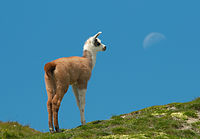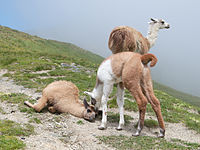- Cria
-
For the Canadian Recording Industry Association, see Canadian Recording Industry Association.
A cria (pronounced cree-ah) is the name for a baby camelid such as a llama, alpaca, vicuña, or guanaco.[1] It comes from the Spanish word cría, meaning "baby". Its false cognate in English, crya (pronounced cry-ah), was coined by British sailors who explored Chile in the 18th century and were quick to describe the camelids onomatopoeically according to the mwa sound they made, which was not unlike that of a human crying baby.[2]
Contents
Alpaca crias
In alpacas, pregnancies last 11.5 months ± 2 weeks, and usually result in a single cria. Twins are rare, approximately 1/1000, slightly rarer than the proportion of twins in human births. Twin cria births are not only rare, but dangerous. A twin birth can kill both the mother and crias. Crias may be weaned through human intervention at approximately 6 months and 60 pounds. However, many breeders prefer to allow the female to decide when to wean her offspring. Offspring can be weaned earlier or later depending on their size and emotional maturity.
Llama crias
Llama crias are typically born with the whole herd gathering around (just the females are present, as the males are considered a threat) in an attempt to protect against potential predators. Llamas give birth standing, and the process is usually relatively quick and problem-free, over in less than 30 minutes. Most births take place between 8 a.m. and noon, during the relatively warmer daylight hours. This may increase cria survival by reducing fatalities due to hypothermia during cold Andean nights. While unproven, it is speculated that this birthing pattern is a continuation of the birthing patterns observed in the wild. Crias are up and standing, walking and attempting to nurse within the first hour after birth.[3][4][5] Llama milk is lower in fat and salt and higher in phosphorus and calcium than cow or goat milk. A female llama will only produce about 60 ml (2.0 US fl oz) of milk at a time when she gives milk. For this reason, the cria must suckle frequently to receive the nutrients it requires.[6]
Vicuña crias
Mating usually occurs in March through April, and after a gestation period of about 11 months the female gives birth to a single cria, which is nursed for about 10 months. The cria becomes independent at about 12 to 18 months.
Religious uses of crias
Incans often use dried cria carcasses to make payments to the earth. Used in ceremony, the crias are burned and the ashes are given as payments to the earth. In the markets of Cuzco, crias are sold for such purposes.
References
- ^ Saunders Comprehensive Veterinary Dictionary, 3 ed. © 2007 Elsevier, Inc.
- ^ History of the New World Called America: Book II, Aboriginal America. Payne, Edward John. Clarendon Press, 1899.
- ^ The Department of Veterninary Clinical Sciences at Ohio State University. Camelid Medicine, Surgery, and Reproduction for Veterinarians. Part II.
- ^ Long, Patrick O.. Llama & Alpaca Neonatal Care. pp. 112.
- ^ Birutta, Gale. A Guide to Raising Llamas. pp. 327.
- ^ Linda March. "Llamas: A Different Kind of Pet". University of Illinois, College of Veterinary Medicine. http://vetmed.illinois.edu/petcolumns/showarticle.cfm?id=222. Retrieved 2009-05-15.[dead link]
Categories:- Camelids
Wikimedia Foundation. 2010.



